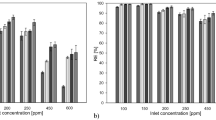Abstract
Volatile organic compounds (VOCs) laden emissions are becoming of great concern in the context of atmospheric pollution, due to their adverse effects on both the environment and human health. Physical–chemical processes (PCPs) and biological processes (BPs) represent widely used solutions for the VOCs degradation. The process limitation by recalcitrant nature and toxicity of the secondary metabolites for BPs and the need for further treatments of the phase in which the contaminants are transferred for PCPs represent critical aspects for the implementation of the conventional processes. To overcome these drawbacks, the development of innovative advanced oxidation processes (AOPs) for the treatment of gaseous organic compounds is of key interest. The research aims at evaluating the performances of UV-assisted ozonation (UV/O3) process for the degradation of VOCs emissions. Toluene was identified as the target compound for the experimental activities. A novel configuration with an additional scrubbing phase is proposed and assessed to improve the removal efficiency and to prevent the release of polluting intermediates of the single-step process. Inlet toluene concentration and applied voltage were varied in order to test the investigated configurations. As inlet concentration was increased, abatement of toluene decreased. An increase in ozone concentration led to an increase in the degradation efficiencies. The additional water-scrubbing step enhanced the abatement of UV/O3 up to 98.5%, due to the solubilization of ozone and by-products in the process water and, thus, the further oxidation of the contaminants within this phase. A maximum elimination capacity (ECmax) of 22.6 g m−3 h−1 was achieved with the UV/O3 + Scrubbing. The combined system boosted higher performance and stability compared to the stand-alone (UV/O3) process along with more economical and environmental sustainability.
Access this chapter
Tax calculation will be finalised at checkout
Purchases are for personal use only
Similar content being viewed by others
References
Cheng, Z.W., Peng-fei, S., Jiang, Y.F., Yu, J.M., Chen, J.M.: Ozone-assisted UV254nm photodegradation of gaseous ethylbenzene and chlorobenzene: effects of process parameters, degradation pathways, and kinetic analysis. Chem. Eng. J. 228, 1003–1010 (2013). https://doi.org/10.1016/j.cej.2013.05.076
Johnson, M.S., Nilsson, E.J., Svensson, E.A., Langer, S.: Gas-phase advanced oxidation for effective, efficient in situ control of pollution. Environ. Sci. Technol. 48(15), 8768–8776 (2014). https://doi.org/10.1021/es5012687
Oliva, G., et al.: Comparative analysis of aops and biological processes for the control of vocs industrial emissions. Chem. Eng. Transac. 68, 451–456 (2018). https://doi.org/10.3303/CET1868076
Oliva, G., et al.: Comparative evaluation of a biotrickling filter and a tubular photobioreactor for the continuous abatement of toluene. J. Hazard. Mater. 380, 120860 (2019). https://doi.org/10.1016/j.jhazmat.2019.120860
Pahunang, R.R., et al.: Advances in technological control of greenhouse gas emissions from wastewater in the context of circular economy. Sci. Total Environ. 792, 148479 (2021). https://doi.org/10.1016/j.scitotenv.2021.148479
Rahmani, F., Haghighi, M., Estifaee, P.: Synthesis and characterization of Pt/Al2O3-CeO 2 nanocatalyst used for toluene abatement from waste gas streams at low temperature: conventional vs. plasma-ultrasound hybrid synthesis methods. Microporous Mesoporous Mater. 185, 213–223 (2014). https://doi.org/10.1016/j.micromeso.2013.11.019
Senatore, V., Zarra, T., Oliva, G., Belgiorno, V., Naddeo, V.: Volatile organic compounds (Vocs) removal by combining bioscrubber and ozone pretreatment. Global Nest J. 22(2), 143–146. (2020). https://doi.org/10.30955/gnj.003298
Subrahmanyam, C., Renken, A., Kiwi-Minsker, L.: Catalytic non-thermal plasma reactor for abatement of toluene. Chem. Eng. J. 160(2), 677–682 (2010). https://doi.org/10.1016/j.cej.2010.04.011
Wang, Z., Xiu, G., Qiao, T., Zhao, K., Zhang, D.: Coupling ozone and hollow fibers membrane bioreactor for enhanced treatment of gaseous xylene mixture. Bioresour. Technol. 130, 52–58 (2013). https://doi.org/10.1016/j.biortech.2012.11.106
Zarra, T., Naddeo, V., Oliva, G., Belgiorno, V.: Odour emissions characterization and impact prediction for anaerobic-aerobic integrated treatment plants of municipal solid waste. Chem. Eng. Transac. 54, 91–96 (2016). https://doi.org/10.3303/CET1654016
Zhan, Y., et al.: A facile VUV/H2O system without auxiliary substances for efficient degradation of gaseous toluene. Chem. Eng. J. 334, 1422–1429. (2017). https://doi.org/10.1016/j.cej.2017.11.056
Author information
Authors and Affiliations
Corresponding author
Editor information
Editors and Affiliations
Rights and permissions
Copyright information
© 2022 The Author(s), under exclusive license to Springer Nature Switzerland AG
About this chapter
Cite this chapter
Oliva, G. et al. (2022). Abatement of Atmospheric Pollutants: UV–Ozone Oxidation for the Degradation of Gaseous Toluene. In: Naddeo, V., Choo, KH., Ksibi, M. (eds) Water-Energy-Nexus in the Ecological Transition. Advances in Science, Technology & Innovation. Springer, Cham. https://doi.org/10.1007/978-3-031-00808-5_81
Download citation
DOI: https://doi.org/10.1007/978-3-031-00808-5_81
Published:
Publisher Name: Springer, Cham
Print ISBN: 978-3-031-00807-8
Online ISBN: 978-3-031-00808-5
eBook Packages: Earth and Environmental ScienceEarth and Environmental Science (R0)




